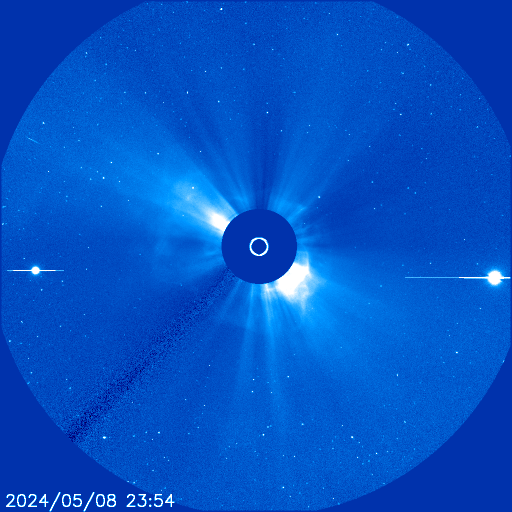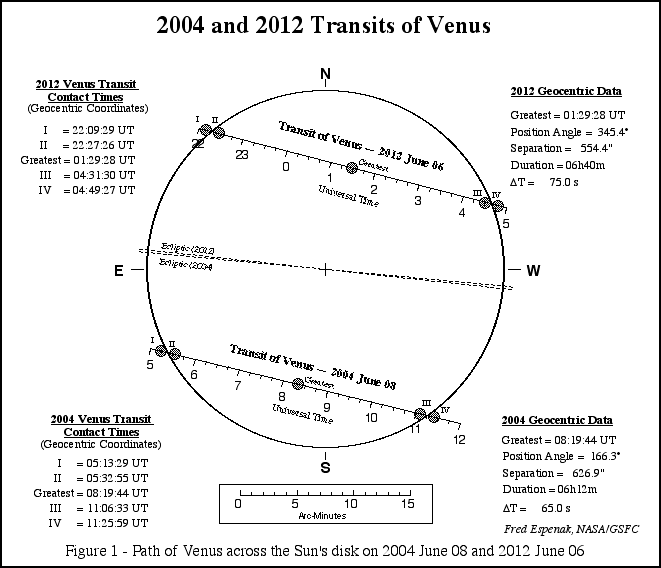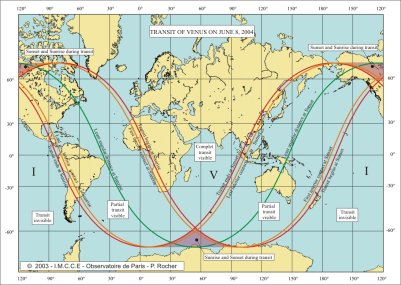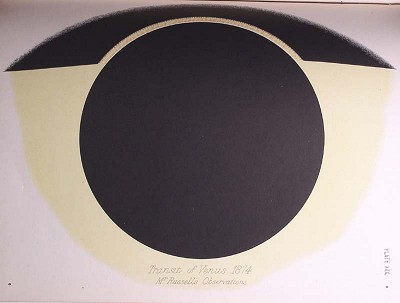
VENUS TRANSIT
June 8, 2004
On Tuesday 8 June 2004 crossed the Sun's disk producing an extremely rare
Venus transit. Venus could could be seen
in silhouet as a large black spot. The transit was observed in its full extent
throughout Asia, Europe, Iceland, Greenland and Africa. It was partially
visible for observers in Australia, Japan, and the eastern states and countries
of the Americas).
Astronet and several other institutions in The Netherlands and Belgium
organized a live webcast of the Venus transit and acted as a node for online
calculation of the Sun-Earth distance through the website venusvoordezon.nl.
Did you measure comtact timings? Please join our observations and enter your contact timings
and geographical coordinates through our Observation
Headquarters.
I shall try to show some of the results that are sent to Astronet soon.
For the time being you might have a look already at the resulats that are
shown at Venusvoordezon.nl
or the
Venus Transit Photo Gallery of SpaceWeather.com.
LIVE WEBCASTS

Between June 3 and June 13 Venus is
visible in SOHO's
coronagraph
LASCO.
|
OTHER LIVE WEBCASTS:
Australia:
NSO/GONG
Theodore Lunar Observatory (Sydney)
CSIRO (Canberra)
Austria:
Österreichische Gesellschaft für Astronomie und Astrophysik (ÖGA2) (Innsbruck/Vienna)
Sonnenobservatorium Kanzelhoehe (Graz)
Universitäts-Sternwarte Wien (Vienna)
Belgium:
Mira Public Observatory (Grimbergen)
Université Libre de Bruxelles
Urania Public Observatory (Hove)
RUG-Volkssterrenwacht Armand Pien (Gent)
Brazil:
IP&D / FCC - Universidade do Vale do Paraíba - UNIVAP
(Peoples Republic of) China
Guangdong (China) Astronomical Society
Czech Republic:
Observatory and Planetarium Hradec Kralove
Express Astronomical Information (Karlovy Vary)
Express Astronomical Information (Brno)
Express Astronomical Information [Streaming video]
Denmark:
Dansk Rumforskningsinstitut (Copenhagen)
Astronomibladet
Egypt:
Expedicion Sonora VT-2004 Egipto (Cairo)
France:
Observatoire de l'Ecole Supérieure d’Optique (St. Etienne)
Observatoire Pic du Midi
Observatoire du Pic de Chateau Renards (Association "Astroqueyras",Hautes-Alpes)
Observatoire de Paris-Meudon
Observatoire de la Côte-d'Azur
Observatoire des Sciences de l'Univers de Besançon
Germany:
Astro-LiveCam Sternwarte (Hattingen)
Observationszentrum (NoRa)
Sternwarte Lohfeld (Bad Salzuflen)
Raumflugplanetarium "Juri Gagarin" (Cottbus)
Wendelstein-Observatorium (LMU München)
Sternwarte Peterberg
Astronomische Vereinigung Karlsruhe
VdS - Vereignigung der Sternfreunde
Kiepenheuer- Institut für Sonnenphysik (Freiburg)
Greece:
Exploratorium (Athens)
Hong Kong:
Hong Kong Astronomical Society
Hungary:
Polaris Observatory (Budapest)
India:
Vygyan Prasar
University of North Dakota V2K4 Expedition (New Delhi)
Nehru Planetarium (New Delhi)
Iran:
Kowsar-1 (K 1) Observatory (Isfahan)
Nojum, The Astronomy Magazine of Iran
ParsSky.net
Isfahan University, Physics Department
Adib Astronomy Society
Italy:
Istituto Nazionale di Astrofisica - INAF
Japan:
Yokohama Science Center, Astronomy Section
Nayoro Astronomical Observatory
Nagoya City Science Museum
Toyama Astronomical Observatory
Nishiharima Astoronomical Observatory
Kawabe Cosmic Park
Hoshinoko Yakata
Nakagawa Science Center
Nagasaki Science Museum
Macao:
Macao Astronomical Society
The Netherlands:
Sander Klieverik at Denekamp
Sterrenkids Webcam
New Zealand:
National Maritime Museum (Auckland)
One Tree Hill Domain
Norway:
Astronomy.no (Oslo)
Poland:
Astronomical Institute of Wroclaw University (in H-alpha line)
Center of Theoretical Physics, Polish Academy of Sciences (Warszaw)
Center of Theoretical Physics, Polish Academy of Sciences (Warszaw)
Lodz Planetarium
Institut of Physics of Szczecin University
Polish Amateur Astronomy Association - Section of Solar Observations
Portugal:
COAA Centro de Observacao Astronomica no Algarve Poio (Portimão)
Centro Multimeios Espinho - Centro de Astrofisica da Universidade do Porto
Reunion:
Astroamateur Jacky FRANCOISE
Observatoire astronomique des MAKES
Romania
Astronomical Institute of the Romanian Academy (Bucharest)
Slovakia:
Slovak Union of Amateur Astronomers - Public Observatory Rimavska Sobota
Spain:
Parque de las Ciencias de Granada
Instituto de Astrofísica de Andalucía
Agrupación Astronómica de Málaga SIRIO
Solar Observation Network NSO/GONG - with images from Observatorio del Teide, Izaña - Tenerife (IAC)
SAROS Live (Gran Canaria, Canary Islands)
Agrupación Astronómica Isla de la Palma
Retransmission together with the Instituto Astrofísico de Canarias (IAC)
Universitat de Barcelona
Agrupació Astronómica Vizcaína - Bizkaiko Astronomi Elkartea y el I.E.S. J.M. Barandiaran de Leioa
Observatorio UCM - Depto. Astrofísica - ASAAF (Madrid)
Saros Group - Scientific Expeditions (Canary Islands)
Saros Group - Scientific Expeditions (Canary Islands)
Agrupación Astronómica de Sabadell (Barcelona)
Instituto de Astrofisica de Andalucia (Granada)
Sri Lanka
Arthur C. Clarke Institute (ACCIMT) (Katubedda, Moratuwa)
South Africa:
Pretoria Centre of the Astronomical Society of Southern Africa
Braam van Zyl, at Boyden Observatory, Bloemfontein
South African Astronomical Observatory
Sweden:
Images from the Swedish 1-m Solar Telescope (SST) in La Palma (Canary Islands)
Switzerland:
Olivier Staiger
Astronomischer Verein Antares
United Kingdom:
Worthill Observatory
Armagh Observatory
East Antrim Astronomical Society (EAAS) (Ballymena)
University of Central Lancashire
Neatherd High School
USA:
Sun-Earth Day: Views with Observatories
Fort Worth Museum
Kidz On-Line
University of North Dakota (UND)
Yugoslavia (Serbia and Montenegro):
Astronomy Club "Milutin Milankovic" (Zrejanin)
Mathematical Dept. of Faculty of Science and Mathematics
IMAGES FROM OUTER SPACE
SOHO:
Hot Shots from SOHO
The very latest SOHO images (ESA)
The very latest SOHO images (NASA)
Passage de Vénus devant le Soleil: observations en temps réel par le télescope EIT/SOHO
TRACE:
Venus Transit 8 June 2004
THE TRANSIT
Transits of Venus across the disk of the Sun are among the rarest of planetary
alignments. Only six such events have occurred since the invention of the
telescope (1631, 1639, 1761, 1769, 1874 and 1882). The next two transits of Venus
will occur on 2004 June 08 and 2012 June 06.

Venus takes more than six hours to track across the Sun. Times shown are Universal Time.
Greatest transit is the instant Venus passes closest to the Sun's center.
Astronomy magazine illustration by Roen Kelly.
The principal events occurring during a transit are characterized by contacts.
The event begins with contact I which is the instant when the planet's disk is
externally tangent with the Sun. The entire disk of the Venus is first seen at
contact II when the planet is internally tangent with the Sun. During the next
several hours, Venus gradually traverses the solar disk at a relative angular
rate of approximately 4 arc-min/hr. At contact III, the planet reaches the opposite
limb and is once again internally tangent with the Sun. The transit ends at
contact IV when the planet's limb is externally tangent to the Sun. Contacts
I and II define the phase called ingress while contacts III and IV are known as
egress. Greatest transit is the instant of minimum angular separation between Venus
and the Sun as seen from Earth's geocenter.

Courtesy: Fred Espenak
The entire transit (all four contacts) is visible from Europe, Africa (except
western parts), Middle East, and most of Asia (except eastern parts).

Courtesy: ESO
The Sun
sets while the transit is still in progress from Australia, Indonesia, Japan,
Philippines, Korea, easternmost China and Southeast Asia. Similarly, the Sun rises
with the transit already in progress for observers in western Africa, eastern
North America, the Caribbean and most of South America. None of the transit
will be visible from southern Chile or Argentina, western North America, Hawaii
or New Zealand.

This is one frame of an animation that shows both the track of Venus across the Sun and
the regions on Earth where the transit will be visible. Contact times and the exact path
Venus will take across the Sun differ slightly for observers in different locations.
The path and times shown here are correct for an observer located at Earth's center,
but contact times will not differ from these by more than 7 minutes anywhere in which
the contacts are visible. The Earth image is centered on the geographical location where
Venus lies directly overhead.
Click for the Astronomy magazine animation (AVI, 1,3 Mb) by Francis Reddy.
SAFETY
The apparent semi-diameters of Venus and the Sun are 29 arc-seconds and 945
arc-seconds respectively. This 1:32.6 diameter ratio results in an effective
0.001 magnitude drop in the Sun's integrated magnitude due to the transit.
This simply means that the Sun will be as dangerous for our eyesight at the
time of the Venus Transit as it is on any normal day, when there is no planet
in front of the solar disc.
NEVER LOOK DIRECTLY AT THE SUN WITH UNPROTECTED EYES - THIS MAY CAUSE TOTAL
BLINDNESS WITHIN SECONDS! ALWAYS BE SURE TO USE PROPER OPTICAL FILTERS TO
PROTECT YOUR EYES.
The use of #14 shade welding glass or eclipse shades will permit a large number
of people who do not have specialized equipment to observe this event.
However, as the planet approaches the limb of the sun, subtleties like the
black drop effect may not be discernible.Pinhole projectors are a safe,
indirect viewing technique for observing an image of the sun. While popular
for viewing solar eclipses, pinhole projectors suffer from the same
shortcomings as unmagnified views when Venus approaches the edges of the sun.
Small features like the black drop effect and the halo around Venus while it
straddles the solar edge may not be discernible.

Courtesy: European Southern Observatory
You may project a magnified view of the sun through a telescope onto a surface,
but the technique often has its own limitations. For example, large reflector
telescopes can generate too much heat by concentrating a lot of the sun's energy
on the secondary mirror and eyepiece. Likewise, Schmidt-Cassegrain telescopes
can experience too much heat build-up as the light bounces internally. Also,
magnified projections usually have an exposed focal point beyond the eyepiece
where bystanders could inadvertently burn themselves. Constant attention is
required.
The transit of Venus is perhaps best viewed directly when magnified, which
demands an appropriate solar filter over the large end of the telescope.
Do not use small filters that fit over the eyepiece, for the concentrated
sunlight can shatter them. The sun's energy must be attenuated before
it enters the telescope. A filtered, magnified view will show the planet Venus,
the "black drop" effect, and sunspots.
No matter what technique you use for viewing the sun, do not stare continuously
at the sun! Always give your eyes a break.
MEASURING THE SOLAR SYSTEM
In earlier times, astronomers used transits of Mercury and Venus to get information
about the dimensions of the solar system: the size of the Sun, the distance of Venus,
and the distance between us and the Sun, which is called the astronomical unit (AU).
To fix that important quantity, astronomers used the method of triangulation.
The first astronomer to recognize the importance of observing transits of Mercury
and Venus was Edmund Halley (1656-1742). It appeared to the observer, using a
telescope as the lens of a camera obscura (never look directly at the Sun through
a telescope!) as a black dot crossing the surface of the Sun. The first astronomers
to use telescopes to observe the transit of Venus were Jeremiah Horrocks (1618-41)
and William Crabtree (1610-44) in 1639.
Astronomers travelled to remote parts of the world to observe the transits of Venus
in 1761 and 1769. To observe the transit of 1769, Captain Cook sailed from England
to Tahiti. He discovered Hawaii and a few other places as bonuses along the way;
it is not often that the side benefits of astronomical research are so apparent.
How accurate were the measurements of Cook? The "dusky shade round the body of the
Planet" as he descrtibed the appearance of Venus was a problem. Intense sunlight
filtering through Venus' atmosphere fuzzed the edge of the disk and decreased the
precision with which Cook could time the transit. For this reason, his
measurements disagreed with those of ship's astronomer Charles Green, who
observed the transit beside Cook, by as much as 42 seconds.

Cook's observations
Cook and Green also observed the "black drop effect." When Venus is near the
limb of the sun--the critical moment for transit timing--the black of space
beyond the Sun's limb seems to reach in and touch the planet. You can recreate
the black drop effect with your thumb and index finger: Hold the two in front
of one eye and narrow the distance between them. Just before they touch,
a shadowy bridge will spring across the gap. According to John Westfall,
writing for Sky & Telescope magazine in June 2004, "this is simply the result
of how two fuzzy bright-to-dark gradients add together." The black drop effect,
like the fuzziness of Venus' atmosphere, made it hard to say just when the transit
began or ended.

Black drop effect
This was a problem for observers elsewhere, too, not only Cook in Tahiti. In fact,
when all was said and done, observations of Venus' 1769 transit from 76 points
around the globe, including Cook's, were not precise enough to set the scale of
the solar system. Astronomers didn't manage that until the 19th century when they
used photography to record the next pair of transits. And even then an incertainty
in the measurements remained.
In recent years, radio signals emitted by spacecraft as they pass behind Venus
have enabled us to obtain very accurate planetary positions and masses, as well
as the distance between the Earth and the Sun. Because of these results from space
exploration, observing this and future planetary transits will be of less scientific
importance, but they will of course continue to be great public and educational
interest.
What else is there to be seen? Look before and during ingress and during and after
egress for a spectacular 'light ring' around the black silhoutte of Venus. This
is caused bu sunlight that is refracted by Venus' thick atmosphere. It was after
observing this light ring in 1761 that Russian astronomer Mikhail Lomonósov
realized that Venus is surrounded by an atmosphere.

The light ring in 1874
Carl Koppeschaar
FURTHER INFORMATION
General information:
Fred Espenak, NASA's GSFC: 2004 and 2012 Transits of Venus
ESO: The Venus Transit 2004
Prof.Dr. Udo Backhaus: Observing, Photographing and Evaluating the Transit of Venus, June 8th, 2004
Steven van Roode: Transit of Venus, 8 June 2004
The Transit of Venus: North American Viewer's Guide
Orpington Astronomical Society: Transit of venus 2004
Venus-transit.de: Transit of Venus, June 8, 2004
David Sellers: The Transit of Venus & The Quest for the Solar Parallax
Transitofvenus.org: Transit of Venus June 8, 2004
Astronomy Picture of the Day: Phases of Venus
History of Venus Transits:
Smithsonian Institution libraries: Chasing Venus, Observing the Transits of Venus, 1631-2004
James Cook and the Transit of Venus
The 1882 Transit of Venus: Observations from Wellington, South Africa.
Jeremiah Horrox: Venus in sole visa
The First Observations of Transits
Transitofvenus.org: Historical Observations and Global Expeditions
Historical Observations of Venus Transits in Iran
The Black Drop Effect
The "Black Drop" Effect
Maps and plots of the Venus Transit:
Daniel Falla and John Brooks: June 8th Venus Transit
Topocentric contact times and corresponding altitudes of the Sun:
Circumstances for Cities (International)
Circumstances for Cities (USA)
Past and future Venus Transits:
Project Pluto: Transits of Venus and Mercury, -1000 to +4000
Safety:
Eclipse Home page: Eye Safety And Solar Eclipses
Transitofvenus.org: Safety!
Sky & Telescope: How to observe the Sun safely
Database with geographical coordinates:
Heavens Above: Select Country
Time synchronization:
UTC Time Zone (accurate within 0.4 seconds)
Chronograph Atomic Time Clock
Solar Parallax Calculation:
Venusvoordezon.nl: Observation Headquarters
Steven van Roode: The solar parallax and the distance of the sun
Weather:
Meteosat Images from the University of Ulm
AccuWeather.com (USA)http://wwwa.accuweather.com/adcbin/public/index.asp?partner=accuweather
Commonwealth Bureau of Meteorology: Current Australian Region Satellite Images
Previous webcasts organized by Astronet:
Total lunar eclipse 4/5 May 2004
Total lunar eclipse 8/9 november 2003
Annular solar eclipse, May 31, 2003
Total lunar eclipse, May 15-16, 2003
Mercury transit, May 7, 2003














